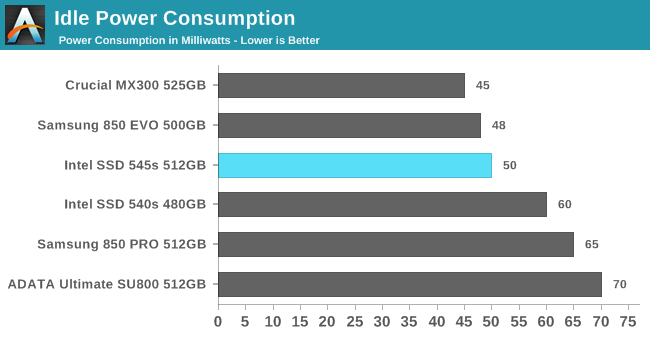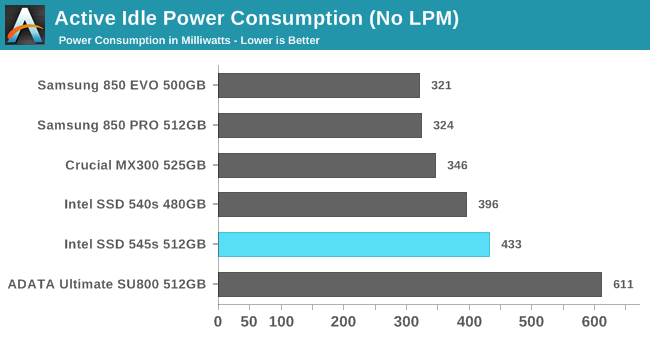The Intel SSD 545s (512GB) Review: 64-Layer 3D TLC NAND Hits Retail
by Billy Tallis on June 27, 2017 6:00 AM ESTIdle Power Consumption
Since the ATSB tests based on real-world usage cut idle times short to 25ms, their power consumption scores paint an inaccurate picture of the relative suitability of drives for mobile use. During real-world client use, a solid state drive will spend far more time idle than actively processing commands. Our SYSmark 2014 SE test covers this case, but because our testbed is a desktop system the SSD's contribution to the total power usage is small and hard to isolate from ordinary variation between test runs.
Our testbed doesn't support the deepest DevSlp power saving mode that SATA drives can implement, but we can measure the power usage in the intermediate slumber state where both the host and device ends of the SATA link enter a low-power state and the drive is free to engage its internal power savings measures.
We also report the drive's idle power consumption while the SATA link is active and not in any power saving state. Drives are required to be able to wake from the slumber state in under 10 milliseconds, but that still leaves plenty of room for them to add latency to a burst of I/O. Because of this, many desktops default to either not using SATA Aggressive Link Power Management (ALPM) at all or to only enable it partially without making use of the device-initiated power management (DIPM) capability. Additionally, SATA Hot-Swap is incompatible with the use of DIPM, so our SSD testbed usually has DIPM turned off during performance testing.

With SATA device-initiated link power management enabled, typical idle power consumption drops by a factor of ten, straining the resolution of our power meter. All of these SATA SSDs have very effective low-power idle states, but the 545s does show clear improvement over the 540s and Intel is now quite close to the Crucial MX300 and Samsung 850 EVO.

The Samsung drives have the best active idle power levels of this bunch, and the Crucial MX300 is not far behind. The Silicon Motion-based Intel 540s, 545s and ADATA SU800 are worst, though only the SU800 is trailing by a large margin. The 545s does draw more power than the 540s, which is not what we would expect from an updated controller design.
Idle Wake-Up Latency
Idle power consumption is not the only important metric of a SSD's power management capabilities. Devices cannot transition in and out of low-power states instantly. It takes time for components to switch back to higher clock speeds and resynchronize their data links to the rest of the system. At the extreme end, the several seconds it takes a hard drive to spin up obviously has a major impact on system responsiveness, and consequently operating systems have to be very conservative about when to put a hard drive to sleep, typically requiring at least several minutes of idle time during which the hard drive is wasting power.
The idle power transition time of solid state drives exists on a very different time scale, but it still matters to systems that are trying to minimize power consumption without sacrificing too much performance. When a SSD only takes a few milliseconds to enter and leave a power saving state, those power saving states can be used far more often, even during sustained interactive use like gaming. The cost of this approach is that far more I/O operations will incur the wake-up latency penalty.
Our equipment is not able to measure how long it takes a SSD to enter a low-power state; this would require very precise synchronization between the CPU and a high-resolution power meter. Timing how long a SSD takes to leave a low-power state is simple: perform one read operation every few seconds, and compare the latency with and without power management enabled. The difference, reported below, includes time taken to reestablish the SATA link and for the SSD to wake up, but does not include the time spent actively reading data from the flash memory since that will be the same whether or not the SSD had just been in a low-power state. Thus, this test is mostly a measure of the SSD controller and its firmware.

The Crucial MX300 has pretty good power consumption both at idle and under load, but its Marvell controller takes far longer to wake up from idle than its competition. At about 3.4ms, the MX300 is almost five times slower to wake up than the ADATA SU800, which has higher idle power consumption. The Intel 545s is a bit on the slow side at 1.4ms, about twice the wake-up latency of the ADATA SU800 or the Intel 540s. The total read latency for the 545s with power management enabled is just over 2.2ms.










74 Comments
View All Comments
woggs - Tuesday, June 27, 2017 - link
Once a nand factory is running on a new generation, it has to sell components. The only path out the door for nand is an SSD (for Intel). A product like this gets out quicker and starts the flow. Not a big money maker but gets the factory running in it's early stages.nevcairiel - Tuesday, June 27, 2017 - link
I hope 64-layer TLC brings us closer to more affordable consumer "mass storage" SSDs. I would love to replace my 3TB storage spinning drive with a SSD, but I would need at least that space again - and right now thats still very expensive.MajGenRelativity - Tuesday, June 27, 2017 - link
That is definitely needed. SSD prices need to continue to decline in order to finally finish off HDD's once and for allHomeworldFound - Tuesday, June 27, 2017 - link
That's going to be a slow process, one the mechanical storage companies are going to want to slow down even further.mkozakewich - Wednesday, June 28, 2017 - link
Why not a 6TB HDD?Mechanical drives look like they'll keep their edge on raw capacity for the foreseeable future. You're best off with a dual system.
Drumsticks - Tuesday, June 27, 2017 - link
The SSD 540 was a disappointing product that honestly should have pretty much never been released. It sucked. This one is much better! It's not the best, but it's certainly competitive, and that performance on the destroyer looks great. Kudos to Intel.We just need the price to go down. I bought a 512GB Crucial MX100 years ago for $163 on sale. It's crazy how high prices have gotten recently.
mkozakewich - Wednesday, June 28, 2017 - link
Ha, I remember just a few years ago when the prices were hovering around $1/GB! It kind of feels weird to hear people complaining about high prices at 30-40¢/GB.Remember the Intel X25-M in 2009 for over $500? For 60 GB? AnandTech covered that by benchmarking application start times compared to HDDs. There was this whole problem with janky SSDs, so they described the problem and ran tests on those other low-end SSDs.
We've come so far!
eddieobscurant - Tuesday, June 27, 2017 - link
The bapco benchmark is useless. The differences are negligible . Please don't include it in the new 2017 benchmark suite.lilmoe - Tuesday, June 27, 2017 - link
Totally disappointed. This just gets a tiny bit closer to the 850 EVO, yet it's a bit more expensive ($20 more for 512GB drives).I was hoping Samsung would be under real pressure to lower prices, but this just makes the 850 EVO seem a bit more competitive; it's a bit cheaper, proven for a while to be reliable (ie: a safer bet), and supports more features like encryption.
Seriously, are they even trying? Hoping some REAL competition is on the way shortly from the others...
I smell price fixing shenanigans.
Impulses - Tuesday, June 27, 2017 - link
It's kind of startling how long the 850 EVO has dominated for... It launched at the end of 2014, over 2.5yrs ago now, and pricing has remained more or less constant for the last 2 years (at least for the 1TB I've bought, same today as in the summer of 2015).When has a single storage product ever had that long of a run without a serious challenger? Even Samsung decided to ride it after quickly iterating (and suffering some issues along the way) thru the 430 - 830 - 840.